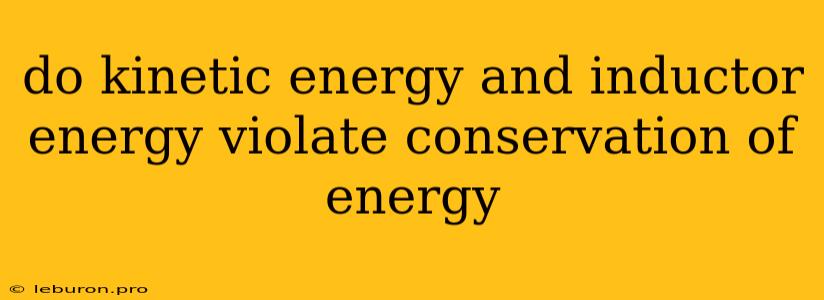The laws of physics are built upon fundamental principles, one of which is the conservation of energy. This principle states that energy cannot be created or destroyed, only transformed from one form to another. However, certain scenarios involving kinetic energy and inductor energy can sometimes seem to defy this principle, leading to questions about whether they violate conservation of energy. This article aims to demystify these apparent contradictions and shed light on how kinetic energy and inductor energy actually fit within the framework of energy conservation.
Understanding Kinetic Energy and Inductor Energy
Kinetic energy is the energy possessed by an object due to its motion. It is directly proportional to the object's mass and the square of its velocity. For instance, a moving car possesses kinetic energy due to its speed and mass.
Inductor energy is a form of stored energy in an inductor, a passive electrical component. Inductors store energy in a magnetic field created when an electric current flows through them. This energy is directly proportional to the square of the current flowing through the inductor and the inductance value.
Apparent Violations of Conservation of Energy
The apparent violation of energy conservation arises when we consider scenarios involving changes in kinetic energy and inductor energy. For example, consider a circuit with an inductor connected to a voltage source. When the circuit is switched on, the current starts to flow through the inductor. This current creates a magnetic field, storing energy in the inductor. As the current rises, inductor energy increases, while the energy supplied by the voltage source seems to decrease. This apparent decrease in the energy supplied by the voltage source may lead to the impression that energy is being lost, violating conservation of energy.
Similarly, when a moving object decelerates, its kinetic energy decreases as its velocity decreases. This loss of kinetic energy may seem to violate energy conservation.
Resolving the Apparent Discrepancies
The key to understanding why these scenarios do not actually violate energy conservation lies in the concept of energy transformation. While kinetic energy and inductor energy are distinct forms of energy, they are interconnected and can be transformed into each other, or into other forms of energy.
In the case of the inductor circuit, the energy supplied by the voltage source is not lost but is transferred into the inductor energy as the magnetic field is created. This energy remains stored in the inductor until the circuit is switched off or the current through the inductor is interrupted. When the circuit is switched off, the magnetic field collapses, releasing the stored inductor energy back into the circuit, either as heat dissipated in the inductor or as energy returned to the voltage source.
Similarly, when a moving object decelerates, its kinetic energy is not destroyed but is transformed into other forms of energy, such as heat due to friction or potential energy if the object is moving uphill.
Examples of Energy Transformation
- A car braking: When a car brakes, its kinetic energy is transformed into heat energy dissipated in the brake pads and tires due to friction.
- A pendulum swinging: As a pendulum swings, its kinetic energy is converted into potential energy as it reaches its highest point, and then back into kinetic energy as it swings back down.
- An electric generator: A generator converts kinetic energy from the rotation of its turbine into electrical energy.
- Charging a capacitor: When a capacitor is charged, the energy supplied by the voltage source is stored as electric potential energy in the capacitor.
- A battery: A battery stores chemical energy which is converted into electrical energy when it discharges.
Conclusion
Kinetic energy and inductor energy are crucial components of many physical and electrical systems. While they can appear to violate conservation of energy at first glance, understanding their interconnectedness and the concept of energy transformation reveals that they always adhere to the fundamental principle of energy conservation. Energy is not lost but transformed from one form to another, demonstrating the intricate web of energy transformations in our universe.
